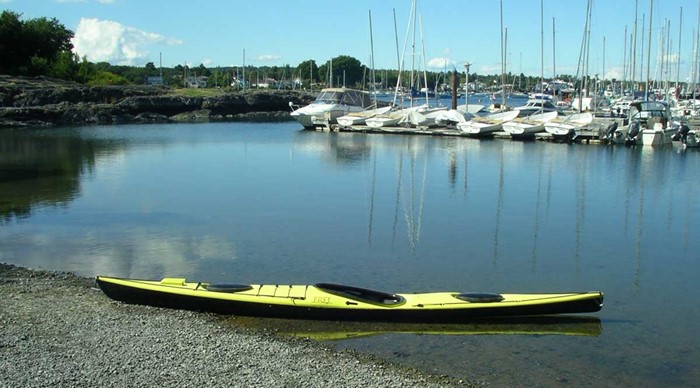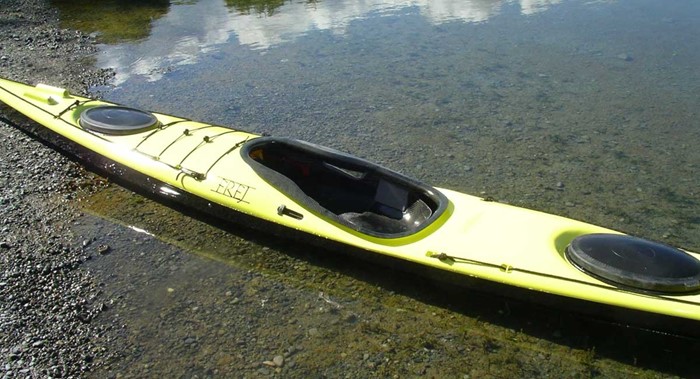Frej – John Abercrombie
den 20 juni 2013 (Frej, Sjösättning), 3 kommentarer

Mail from John Abercrombie, with the first transatlantic Frej finished and launched (here is a post from the project start):
First impressions of Frej:
Good boat! ;-)
Conditions were very quiet- a few ripples and 5-10 kn breeze, so not much of a test of boat (or paddler).
Stability: I wouldn't hesitate to put a beginner in this boat- it is very 'quiet' in the water- good initial stablility. I had no trouble paddling with my knees in the middle of the cockpit ('sorta K1'style). The boat feels very predictable on edge as well. When I was playing around with re-entries, I could easily sit on the back deck with a few inches of water in the boat, and paddle around.
Tracking: I definitely felt like the boat was 'sitting on top of the water' and it was easy to spin it around 180 deg with a sweep and a bow rudder, even with little speed. Hanging draws were easy- throw the paddle in anywhere around the cockpit and the boat moves sideways - no searching for that 'magic spot'. However it was pretty easy to manage when paddling forward.
Skeel: I like it a lot. This boat and the skeel are a great match, I think. An inch or two of skeel and the boat is still very maneuverable but goes where it is pointed with no fuss.
Re-entry: I was a bit concerned that the low deck aft the cockpit would get too close to the water when doing a cowboy/scramble re-entry. Not a problem at all. Even with 3 inches or so of water in the boat there was lots of freeboard aft. In rough conditions it's always easy to get water slopping into the boat (in my limited experience) but I don't think it would be any worse in the Frej than in my Romany, for example.
This would be a great boat for teaching cowboy re-entry as the low back deck is easy to slide up on.
Rolling: I'm a beginner roller (sweep roll with layback-style finish), but the Frej certainly snaps right up - comparable to the Romany, or perhaps even a bit easier with the low aft deck.
Speed: It felt quick for a 16 foot boat, but I was alone and didn't have a GPS, so no data there. There's a fair bit more waterline than on the Romany, and it did feel like it was quicker ...but I may have been a bit more 'hyped' with the new boat.
It feels like a lot of fun, and I would put a beginner or especially a smaller paddler in it without a second thought.
[---]

I painted the deck the same color as my wife's Romany - the pics don't show it very well. It turns out that it's a '96 VW/Audi color. I took my wife's boat to the auto paint supply place and they scanned the color.
On the deck, I used a Valspar automotive 2-part urethane paint (which can be rolled or brushed with the right reducer, according to the spec sheet) over 2-part primer. The hull was painted with Interlux 2-part LPU (Flag Blue) over 2-part epoxy primer (black). 'Sheer stripe' is black.
I put a coat of Interlux Perfection LPU clear on the carbon coaming.
The reason I tinted the glass and fill coats was to make the inevitable scratches a bit less obvious. Getting away from a varnish finish is 'liberating', but definitely 'the primrose path' to the dark world of filler! (Bondo, here we come!) ;-)
More info and pics on Kayak Building Forum

